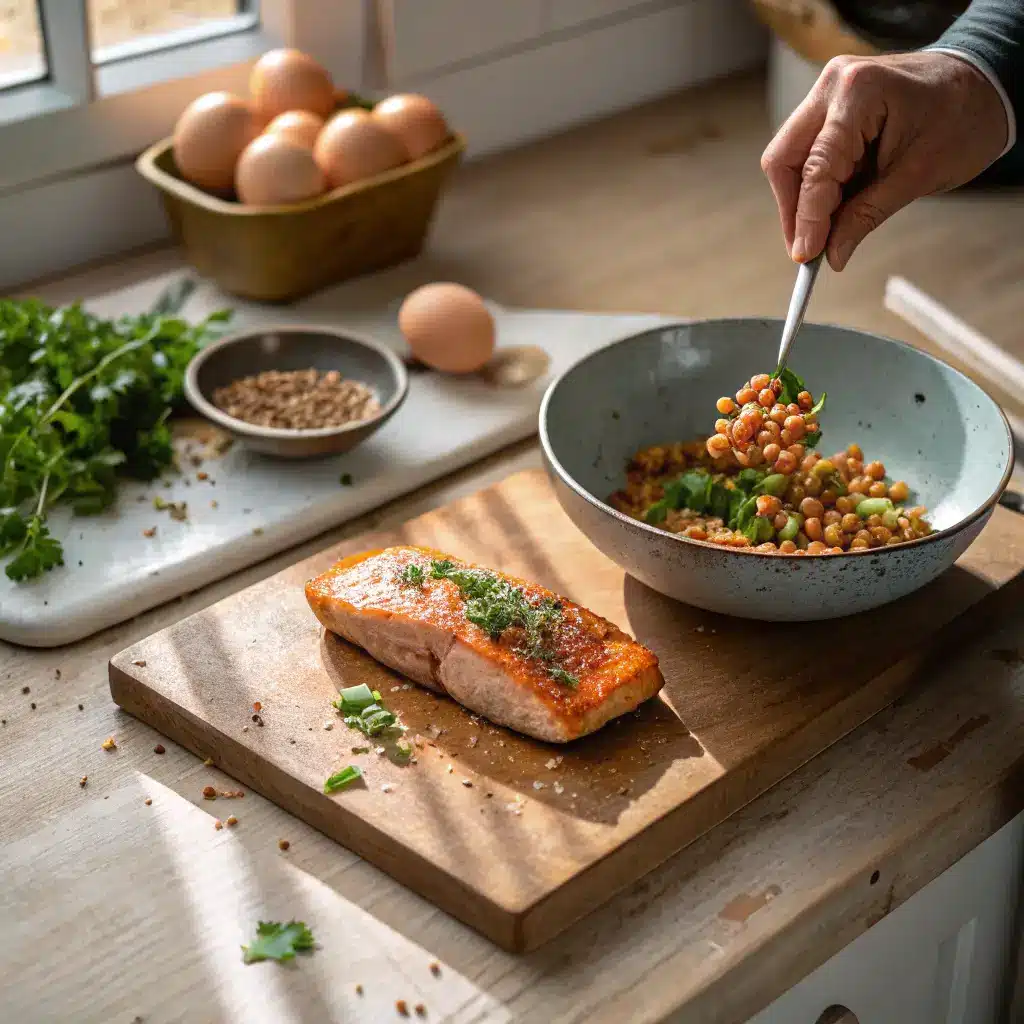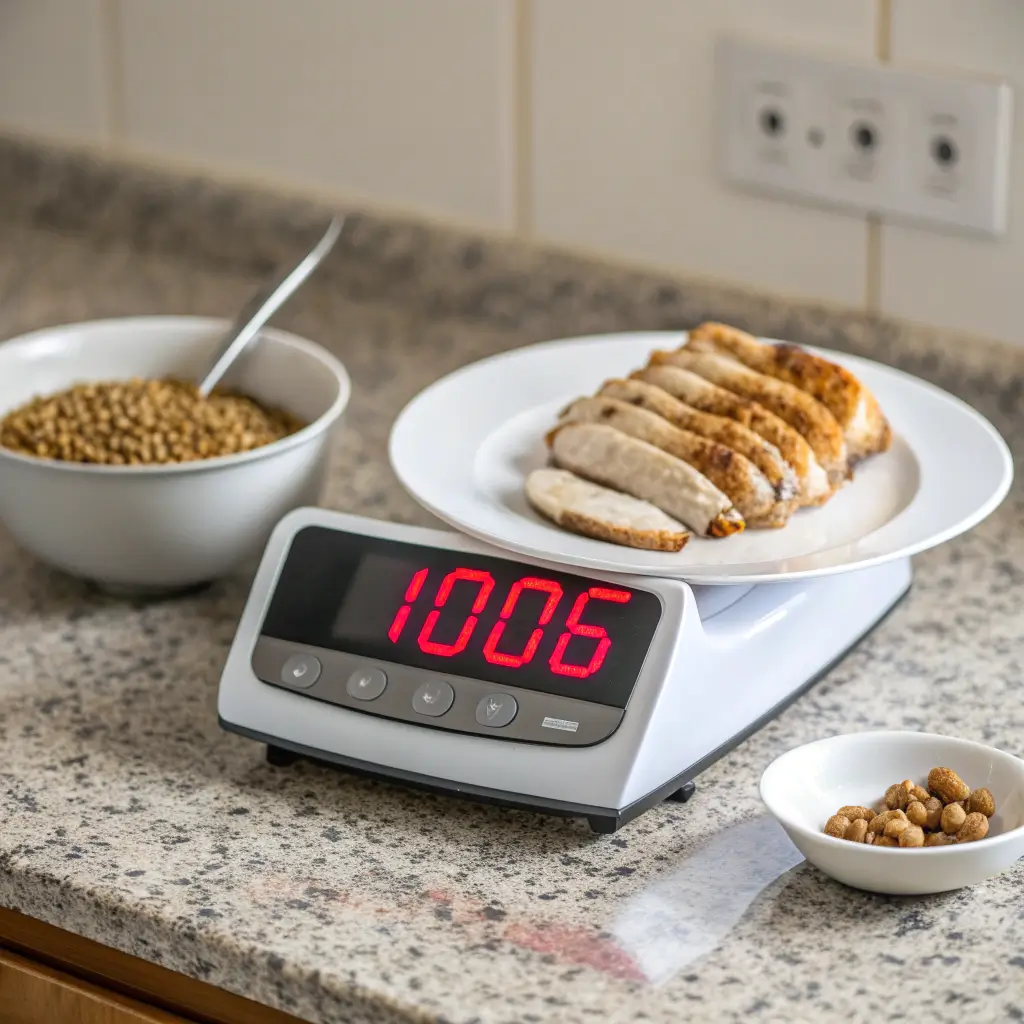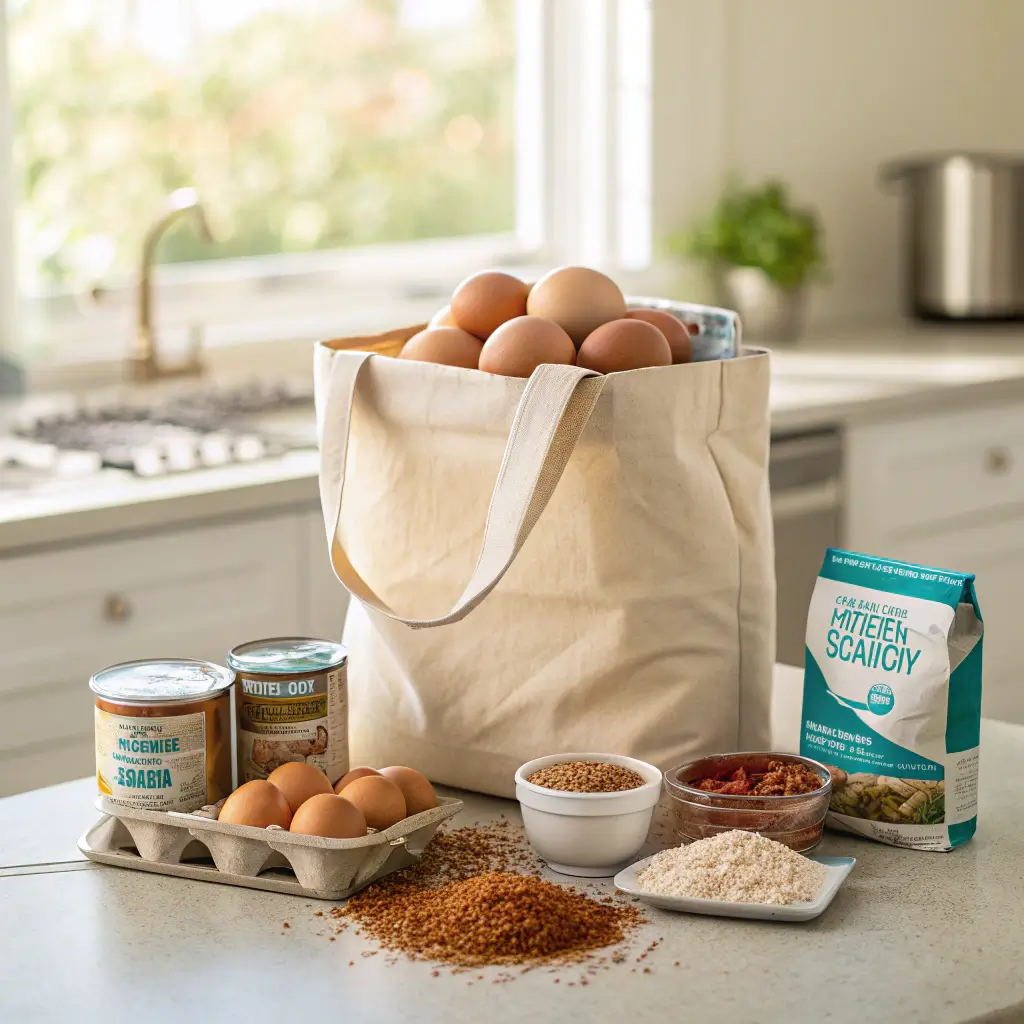
Let’s get real. Everyone’s obsessed with protein—it’s the king of nutrition. But screaming “PROTEIN!” while chugging chalky shakes isn’t the whole story. The real magic is understanding that not all protein is equal. The real game is in the high protein foods comparison; a can of tuna is not a handful of lentils.
The complete vs. incomplete protein debate is overblown. Complete proteins (animals) have all essential amino acids; incomplete (plants) miss some. But eat variety throughout the day—rice and beans—and you’re fine. Don’t let perfection be the enemy of good diet.
Recent research shows 71% of Americans now prioritize protein consumption, up from 59% in 2022, with high-protein diets showing benefits for muscle repair and weight loss.(1)
Table of Contents
Table of Contents
The Ultimate High Protein Foods Comparison: Macros and Mayhem
Alright, let’s talk numbers, because numbers don’t lie. A protein chart per 100g is your best friend here. In our quest for the highest protein foods per 100g, you’re looking at the usual suspects.
Here’s a simple text-based protein comparison chart you can add directly to your WordPress post:
High Protein Foods Comparison Chart
Protein content per 100g serving
Animal Proteins
| Food | Protein (g) | Calories | Notes |
|---|---|---|---|
| Chicken Breast | 31g | 165 | Lean, versatile |
| Turkey Breast | 30g | 135 | Very lean |
| Tuna (canned) | 29g | 132 | Budget-friendly |
| Lean Beef | 26g | 250 | Higher calories |
| Salmon | 25g | 208 | Omega-3 rich |
| Eggs | 13g | 155 | Affordable, versatile |
Dairy Options
| Food | Protein (g) | Calories | Notes |
|---|---|---|---|
| Cottage Cheese | 11g | 98 | Low sugar, filling |
| Greek Yogurt | 10g | 59 | Popular choice |
Plant-Based Proteins
| Food | Protein (g) | Calories | Notes |
|---|---|---|---|
| Almonds | 21g | 579 | High calories |
| Tempeh | 19g | 192 | Fermented soy |
| Tofu | 15g | 144 | Versatile |
| Quinoa | 14g | 368 | Complete protein |
| Lentils | 9g | 116 | High fiber |
| Black Beans | 9g | 132 | Budget-friendly |
Chicken breast, that boring but effective workhorse of every fitness diet, clocks in at a whopping 31g. It’s the beige Toyota Camry of protein. It gets the job done. Tuna and lean beef aren’t far behind. These always dominate the top 10 protein foods lists for a reason.
But hold on. This high protein foods comparison gets way more interesting when you look at the world of high protein vegetarian foods. Lentils, man. For pennies on the dollar, you get 9g of protein plus a ton of fiber that will keep you full for hours. And don’t even get me started on the dairy aisle drama. I used to be a Greek yogurt purist, until I fell down a rabbit hole comparing cottage cheese vs Greek yogurt and my whole world changed. Seriously, some cottage cheese has more protein and less sugar—mind blown.
It’s like finding out the sidekick was the real hero all along. If you want to go even deeper, check out the cottage cheese vs ricotta protein smackdown. But protein grams, as seen on any protein food chart in grams, are just one piece of the puzzle. What about the calories hitching a ride? That chicken is super lean. Almonds? They have lots of protein too, but they’re also a calorie bomb, like a delicious, crunchy Trojan horse.

The Complete Guide to Plant-Based Complete Proteins
Let’s bust the myth that you need meat for complete proteins. Sure, most plants are missing one or two essential amino acids, but several plant foods are complete protein powerhouses all on their own.
The Plant-Based All-Stars:
Quinoa – This ancient grain is the overachiever of the plant world. At 14g protein per 100g, it contains all nine essential amino acids in proper ratios. It’s technically a seed, not a grain, which explains why it’s so nutritionally dense. Cook it like rice, toss it in salads, or use it as a base for protein bowls.
Soy Products (The Triple Threat):
- Tempeh (19g per 100g) – Fermented soybeans that taste nutty and substantial. The fermentation process makes it easier to digest and adds probiotics. It’s like tofu’s more interesting cousin.
- Edamame (11g per 100g) – Baby soybeans that make the perfect snack. Steam them, sprinkle with salt, and you’ve got complete protein in pod form.
- Tofu (15g per 100g) – The chameleon of proteins. Firm tofu works great cubed and stir-fried, while silken tofu blends into smoothies or desserts.
Hemp Seeds (31g per 100g) – Yes, you read that right. These tiny seeds pack more protein per gram than chicken breast. They have a mild, nutty flavor and contain all essential amino acids plus healthy omega fatty acids. Sprinkle them on everything.
Chia Seeds (17g per 100g) – These little guys expand when wet, creating a gel-like texture perfect for puddings. They’re complete proteins with the bonus of fiber and omega-3s.
Buckwheat (13g per 100g) – Despite the name, it’s not wheat and it’s gluten-free. Use buckwheat flour for pancakes or cook whole buckwheat groats as a hearty side dish.
The Power of Protein Combining: Even if you stick to “incomplete” proteins, combining them throughout the day creates complete amino acid profiles:
- Rice + Beans = The classic combo that feeds billions
- Hummus + Whole Wheat Pita = Middle Eastern wisdom
- Peanut Butter + Whole Grain Bread = Childhood comfort with complete nutrition
- Oats + Almonds = Perfect breakfast combination
Plant Protein Hacks:
- Nutritional yeast (45g per 100g) – This cheesy-tasting powder is a complete protein and B12 source
- Spirulina (57g per 100g) – This blue-green algae is the protein king, though you’ll only use small amounts
- Plant protein powders – Look for blends that combine pea, rice, and hemp proteins for complete amino acid profiles
The bottom line? Plant-based complete proteins aren’t rare unicorns. They’re sitting right there in your grocery store, often in the bulk bins, waiting to prove that you don’t need to sacrifice protein quality just because you’re skipping the meat aisle.
In the Trenches: What Actually Works in Your Kitchen
Nutrition science is great, but it means nothing if you can’t actually apply it to your chaotic life. I’m talking about Tuesday night when you’re exhausted and just want to eat. The best protein foods list for weight loss is utterly useless if you hate cooking everything on it.
Meal prep. Some foods are built for it. I’ll cook a massive batch of chicken or ground turkey and it’s good for days. But have you ever tried to meal prep tilapia? By day two, your fridge smells like a forgotten corner of a fish market. It’s a tragedy. Lentils and beans, on the other hand, are champions. They just sit there, getting more flavorful. Convenience is a whole other battle.
A scoop of cottage cheese takes zero seconds. Zero. Frying up some tofu? Maybe ten minutes. Trying to make a tough cut of beef tender… well, I hope you cleared your schedule for the afternoon. And versatility! Tofu can be anything it wants to be—scrambled, fried, blended into a sauce. It’s the Meryl Streep of proteins. Salmon is amazing, but it always tastes like salmon, you know? It’s not fooling anyone.
Your Gut Feelings: Digestion, Fullness, and All That Jazz
How your body uses the protein is a huge deal. It’s not just about what goes in. A good high protein foods comparison has to consider this. Whey protein is like a sprinter—it gets absorbed super fast, which is why people chug it right after a workout. Then you have casein (the main protein in cottage cheese), which is a marathon runner. It digests slowly, feeding your muscles all night long. It’s my secret weapon for staving off midnight hunger pangs.
The real superstar quality of protein is satiety. That feeling of being full and satisfied. It’s a game-changer. Research shows that acute protein ingestion suppresses appetite, decreases ghrelin (hunger hormone), and increases satiety hormones cholecystokinin and GLP-1 (2) Fiber helps too, which is why a bowl of lentil soup feels so much more substantial than its calorie count would suggest. It’s not just food; it’s a fortress against snacking. Trying to time all this perfectly is… a choice. Just try to spread your protein intake out. It’s better than saving it all for one giant dinner, like you’re a python swallowing a goat.
The Money Talk: Budgets and Bulk Bins
Let’s be honest, we can’t all afford wild-caught salmon and grass-fed everything. With food prices going nuts lately (remember the great egg crisis of ’23?), being smart is non-negotiable. The financial side of this high protein foods comparison is where things get really real. A good protein foods list for weight loss has to be affordable. Eggs, when they aren’t the price of gold, are fantastic. Canned tuna. Lentils. Dried beans. These are the unsung heroes. Buying in bulk is your superpower. That giant bag of protein powder or lentils might seem expensive upfront, but it saves you so much in the long run. It’s about playing the long game.

The Final Verdict: What Should YOU Eat?
Okay, to wrap up this whole high protein foods comparison, let’s tailor it to you. Your goals dictate your choices.
- Weight Loss Crusader: You want maximum fullness for minimum calories. Your protein foods list for weight loss should be lean and mean. Stick with chicken breast, egg whites, fish, and Greek yogurt. And seriously, get on the cottage cheese train. Our cottage cheese macros guide is a great place to start. These foods are your shield against mindless eating.
- Muscle-Building Machine: You need fuel. Lots of it. Complete proteins are your priority. Chicken, lean beef, fish, whole eggs, dairy. Don’t be afraid of a little fat, it has its place. Your body is a construction site, and you need to supply all the bricks.
- Just Trying to Be Healthy: Chill out and eat everything. Seriously. Variety is your best friend. Get some fish for omega-3s, some beans for fiber, some chicken for lean protein. Your body thrives on diversity. Don’t get stuck in a rut.
- The “I Have No Time” Professional: Convenience is your god. Embrace it. Protein shakes, pre-cooked meat, hard-boiled eggs, canned tuna, yogurt cups. These are your tools to win the day without living in the kitchen.
At the end of the day, the best protein source is the one you’ll actually eat consistently. Find what you like, what you can afford, and what fits your life. Now go eat something.
FAQs (The Stuff People Always Ask)
1. What food has the highest protein per 100g?
If we’re being pedantic, pure protein powder isolate. But when people look at a highest protein foods chart for actual food you chew, it’s lean chicken or turkey breast, hovering around 31g. It’s a beast.
2. How do vegetarians not just wither away from a lack of protein?
It’s surprisingly easy! Many high protein vegetarian foods like tofu, tempeh, edamame, and quinoa are complete proteins all on their own. Plus, the ancient magic of combining foods like rice and beans or hummus and bread gives you everything you need. It’s not rocket science.
3. Are there high protein fruits? I feel like there aren’t.
You’re mostly right. Fruit isn’t where you go for protein. But, for a fun fact, guava is the surprising winner with about 4g per cup. It’s more of a fun bonus than a real strategy, though. Stick to meat or beans for the heavy lifting.
4. Should I slam a protein shake the second I finish my last rep?
The whole “anabolic window” thing is a bit less dramatic than we used to think. It’s not a window that slams shut. Just aim to get some quality protein and carbs in within a couple of hours of your workout. Your muscles will thank you. Don’t stress the timing down to the minute.
